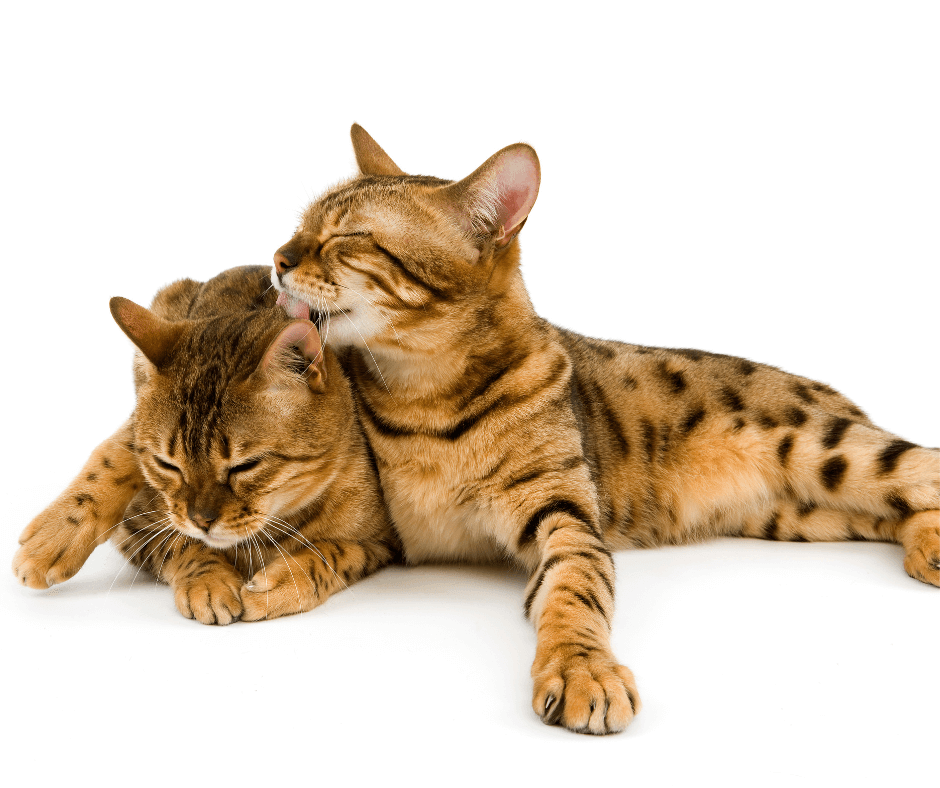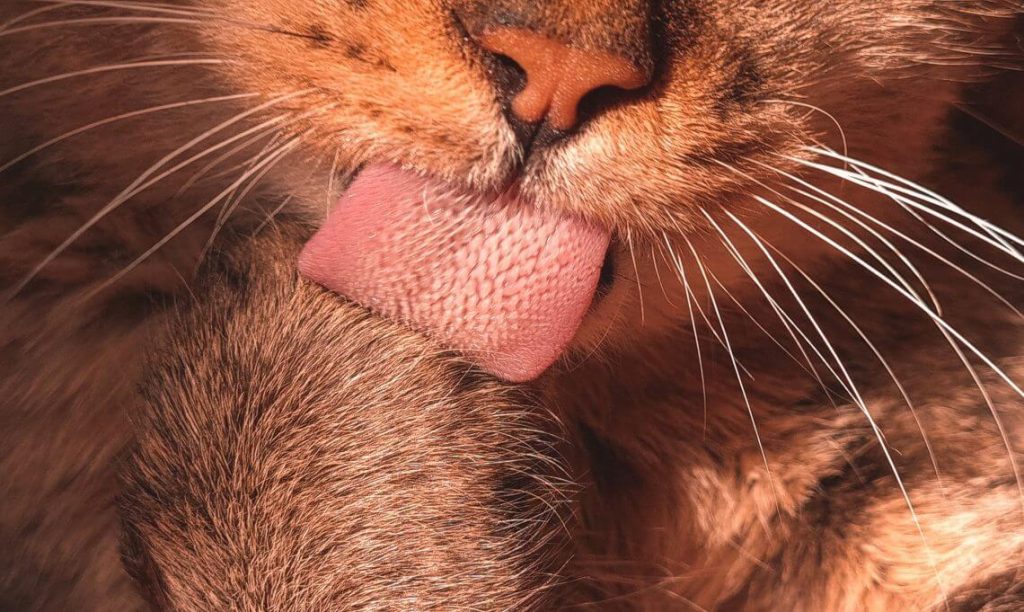Cat Grooming and Furballs

Our felines spend much of their time cleaning and preening themselves, but self-grooming contributes to their health, wellbeing and safety, too. For us cat folk, the occasional furball is no cause for alarm. But we do need to know when vomiting is a sign of illness. We take a look at cat grooming and furballs.
A Cat’s Tongue
Cats are fastidious groomers that spend a substantial amount of their time cleaning their coats. In fact, a cat will use up a quarter to half of their waking hours cleaning and grooming themselves.
If you’ve ever experienced the lick of a cat – an endearing sign of affection; more on that later – you know the rough texture of a cat’s tongue. What may feel like sandpaper is actually more like tiny angled spines called filiform papillae. They are made of keratin, the same stuff hair and nails are made from. Much like a brush, their tongues comb through their coats, picking up dirt, bugs and unattached strands of fur.
Cats also use these hard spines to make short work of stripping meat from bones.

Grooming – More Than Vanity
So it’s not just about looking good, as fitting as that would be. Self grooming fulfils essential health and protection roles, too.
Grooming helps cats regulate their body temperature. Cats only sweat from their paw pads and noses, say Pet Doctors on the Gold Coast, QLD, where summer in the coastal holiday city reaches an average of 30°. Sweating so little leaves our furry felines susceptible to heatstroke. The saliva on their fur evaporates, removing heat from their bodies in hot weather in the same way that sweat cools our bodies.
Self grooming also maintains their coats, keeping them soft and conditioned. As cats groom, their natural skin oils are distributed all over their fur.
But there is a precautionary reason cats groom themselves so thoroughly. Instinctively, cats know that removing their own smell and food odours provides added protection against potential predators. Though they are predatory animals, they are small, making them a target for a larger animal looking for a kill, or a rival cat vying for extended territory.
Another reason cats groom is to calm themselves down when they feel anxious and stressed. The self-soothing act of grooming lowers their heart rate and restores the feeling of calm. It may be intuitive, or it may be learned; a cat is generally at ease and relaxed when grooming.
If you watch a grooming cat, aside from the cute factor you will notice their eyes are closed. A cat can snooze with their eyes slightly open, to stay on the lookout for danger. So closing their eyes is a big deal, and only occurs when they feel safest. Read Catnaps — The Sleeping Behaviour of Cats for more.
If you are fortunate to have more than one cat, they may groom each other. Cats will use grooming to maintain close bonds. A mother cat grooms her kittens to keep them clean, and to stimulate their bowels. Kittens don’t groom themselves until they are four or five weeks old. If you have a strong familial bond with your cat, they may even want to groom you.
A change in your cat’s grooming habits may be a sign of ill health. If they are over grooming, causing a loss of fur, or conversely, neglecting to groom themselves, take your cat to your veterinarian.
Furballs
Also known as hairballs, furballs will sometimes form in a cat’s stomach. Most of a cat’s fur will pass through their digestive system, so the expulsion of a furball should be an infrequent occurrence. But every cat is different, and the production of furballs depends upon the breed and habits of a cat. It also makes sense that cats that shed a lot or have long fur will lose more fur in spring and summer than a low shedding cat in winter.
At your next check up, your veterinarian can advise on the normal frequency of furball production for your feline. If vomiting is frequent, more than once every month, take them for a check up.
When Vomiting Signals a Problem
Look out for the following symptoms. They indicate a health problem and the urgent attention of your veterinarian.
- Frequent vomiting or retching
- Diarrhoea
- Constipation
- Lethargy
- Loss of appetite
Minimise and Ease Furballs
There are things you can do to minimise the amount of fur that enters your cat’s digestive system, and to ease out the fur that does.
1. Regular Brushing
Brushing your cat will remove excess fur, saving it landing in their stomach. You would be surprised at how much fur a cat brush will collect. Begin brushing as early as you can in your cat’s life. While it is a loving way to spend some time with your cat, some may not allow it. This writer’s cat permits no more than three strokes of a cat brush, attacks the brush and then cuts our cuddle time short.
Grooming is especially important during high shedding seasons leading up to summer.
2. Access to Cat Grass
Cat grass contains fibre as well as nutrients that facilitate the natural removal of stubborn furballs, which is one of the reasons cats seek it out. Rather than eating any unknown grass variety or a potentially dangerous plant, give them cat grass. Read All You Need to Know About Cat Grass and Catmint for more.
3. Furball Formulations
Your veterinarian may recommend a laxative or a formulated food to minimise furballs. Coconut oil has been reported to assist with stubborn furballs, though more research is needed. A small amount of extra virgin olive oil will not harm your cat and may be all it takes to shift their stomach contents, either end. Be warned that any such change to your cat’s dietary intake can have quite an impact. It is best to try natural remedies under veterinary supervision.
4. Access to Water
Just like us, things will not move through the digestive tract efficiently without adequate hydration. This is even more important with cats that eat dry food. Give them access to lots of water. If your cat won’t drink water from a bowl, try a wider one. Cat whiskers are very sensitive; the sides of the bowl touching their whiskers may be an irritation. Read more about this in The Cat’s Whiskers.
Cats have amazing tongues perfectly designed to clean and condition their coats, keeping them cooler in hot weather. Look out for excessive vomiting and the symptoms mentioned above, and see your veterinarian. Use these tips to spare them from vomiting as many furballs. And let’s face it, we can also spare ourselves from cleaning them up.
